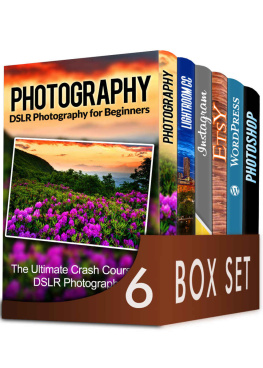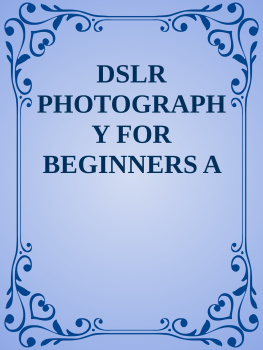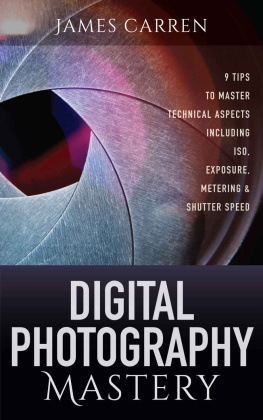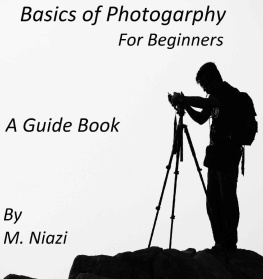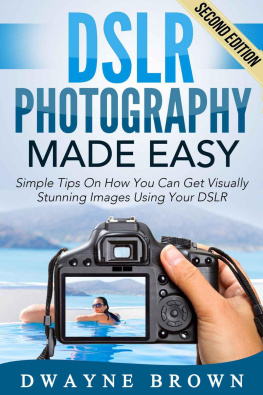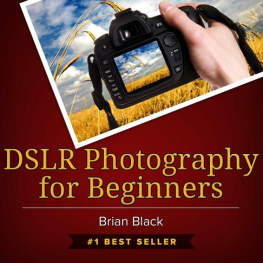James Clark - Photography: The Beginners Crash Course in DSLR Photography
Here you can read online James Clark - Photography: The Beginners Crash Course in DSLR Photography full text of the book (entire story) in english for free. Download pdf and epub, get meaning, cover and reviews about this ebook. year: 2016, publisher: UNKNOWN, genre: Home and family. Description of the work, (preface) as well as reviews are available. Best literature library LitArk.com created for fans of good reading and offers a wide selection of genres:
Romance novel
Science fiction
Adventure
Detective
Science
History
Home and family
Prose
Art
Politics
Computer
Non-fiction
Religion
Business
Children
Humor
Choose a favorite category and find really read worthwhile books. Enjoy immersion in the world of imagination, feel the emotions of the characters or learn something new for yourself, make an fascinating discovery.

- Book:Photography: The Beginners Crash Course in DSLR Photography
- Author:
- Publisher:UNKNOWN
- Genre:
- Year:2016
- Rating:3 / 5
- Favourites:Add to favourites
- Your mark:
- 60
- 1
- 2
- 3
- 4
- 5
Photography: The Beginners Crash Course in DSLR Photography: summary, description and annotation
We offer to read an annotation, description, summary or preface (depends on what the author of the book "Photography: The Beginners Crash Course in DSLR Photography" wrote himself). If you haven't found the necessary information about the book — write in the comments, we will try to find it.
James Clark: author's other books
Who wrote Photography: The Beginners Crash Course in DSLR Photography? Find out the surname, the name of the author of the book and a list of all author's works by series.
Photography: The Beginners Crash Course in DSLR Photography — read online for free the complete book (whole text) full work
Below is the text of the book, divided by pages. System saving the place of the last page read, allows you to conveniently read the book "Photography: The Beginners Crash Course in DSLR Photography" online for free, without having to search again every time where you left off. Put a bookmark, and you can go to the page where you finished reading at any time.
Font size:
Interval:
Bookmark:
Photography
The Beginners Crash Course in DSLR Photography
by James Clark
2016 James Clark
All Rights Reserved
Disclaimer
While all attempts have been made to verify the information provided in this book, the author does not assume any responsibility for errors, omissions, or contrary interpretations of the subject matter contained within. The information provided in this book is for educational and entertainment purposes only. The reader is responsible for his or her own actions and the author does not accept any responsibilities for any liabilities or damages, real or perceived, resulting from the use of this information.
So you have been taking amazing pictures with your awesome smart phone camera and you have decided to take the next step and learn how to use a DSLR camera; easy right? Sure, if you recognize all of the buttons, settings, lenses, lighting techniques, aperture, and ISO operations that sweet DSLR camera is capable of using.
Do n t freak out, it actually is easier than is sounds, there is even a setting on most DSLR cameras that will allow you to jus t Point and Shoo t , but I would n t recommend spending a large sum of money to point and shoot.
As you read through this book you will become more than familiar with the terminology associated with DSLR photography. You will learn every setting on that camera and how to use them. You will also learn how to change lenses and why you would want to change lenses.
Lighting, aperture, ISO, will all become second nature to you as you embark on a hobby that will keep you busy for eons; there is always something that needs to be photographed!
For many, the new micro cameras on smart phones have more than enough pixels to create a clear, printable picture, and they are content. For others, like you and me, the camera on the phone will not produce the content we are envisioning, s o on to the DSLR.
The DSLR can do everything a phone camera can do and WAY more. You knew it could do amazing things when you first picked up that DSLR and had a look at all of those settings!
Who knows, your newly learned talent may make you a few bucks too. There are many ways to make some cash with digital photography if you have a talent for it. The global market is full of people who craft and sell it; many of them need images of their items to sell online.
Lighting and composition is important for these types of photos, if you practice, you may find a way to make a few bucks doing something you love.
If making money is n t part of your future, you may still end up th e famil y photographer and you will have to bring your camera to each and every family function from now until the end of time. Ok, this may be a bit dramatic, but your skills will be in demand, everyone will want to know how you learned to take such beautiful pictures.
This book covers everything you need to know, but it is not camera specific. All DSLR cameras have similar functions, and the language/terminology is the same for all DSLR cameras. Some cameras have more, some have less functions, and you will learn how to use all of them so regardless of the camera you have, you will learn to use it like a pro.
Some of the most popular DSLR cameras are produced by Cannon and Nikon. These two top many of the professional lists of top DSLR cameras, and they are always listed on the best photography hobby sites and magazines.
These two companies have been producing photography gear for decades, way before the first digital cameras appeared on the scene so they know a thing or two about taking really great pictures.
Now pull that awesome piece of picture taking equipment out of the bag, box, drawer, closet, where ever it is stashed, and le t s get started. Each chapter is labeled so if you already have some skills, you can skip what you know and get to the stuff you need to know while the rest of us move at our own pace.
All DSLR cameras have similar functions and settings. It really does n t matter if you have a Canon or a Pentax, learning to use the manual settings will be the same. You may have to check out your camera to find the right buttons, switches, and settings, but they are there, trust me.
Manual settings allow you to decide how you want your picture to look. You will not be great at using these setting right out of the box, it takes a bit of practice to gain the skills.
It is worth taking the time to learn manual settings, these settings make the difference between taking a picture with your camera phone, and taking an awesome photograph with a technical skill and artistic flair.
Here is a list of some of the common settings on a DSLR camera:
- P (Program Mode)
- A or AV (Aperture Priority)
- S or Tv (Shutter Priority or Time Value)
- M (Manual Mode)
- ISO speed
Program Mode - On the dial of the DSLR camera you will find the letter P, this P stands for program mode. Program mode allows the camera to calculate aperture and shutter speed when an ISO is already set or selected. When the camera is in program mode the exposure is automatic but the other camera settings are manually set. In Full automatic mode, all of the settings are automatic.
A or AV A stands for aperture priority, and AV stands for Aperture Value. This mode allows the aperture to be set manually while the shutter speed is set automatically for the best exposure with a set ISO sensitivity.
S or Tv S stands for Shutter Priority and Tv stands for Time Value. With this setting the shutter speed is set manually and the aperture is set automatically by the camera for the best exposure with a set ISO sensitivity.
M M stands for Manual Mode. In full manual mode, the shutter speed, aperture, and ISO are set manually by the photographer according their preferences.
ISO spee d ISO is used to set the light sensitivity of the image sensor. This setting determines how sensitive to light the camera will be.
All of the manual settings give you the ability to fine tune the exposure of the pictures you take. Unlike auto settings, the manual settings will allow you to control the exposure quality and artistic feel of your images. Tweaking the manual settings will provide you with the ability to take perfect photos in a number of lighting conditions.
In some situations, automatic settings will not give you the best exposure. When lighting is too bright, or too dark, or when there are too many shadows, or any other extreme in the ambient lighting, manual settings will give you a much better picture quality if you know how to use them. If you are interested photographing moving subjects, objects, or even moving water, the manual settings on your camera will give the best results.
Nature photography is another situation where manual settings will provide a better picture. Nature is never predictable; animals, the weather, and dynamic landscapes are always in motion or change from one state to another.
Using automatic settings will not give you the versatility you need to produce the best picture your camera is capable of taking in every natural setting.
Actually, almost every situation can benefit from using manual settings as long as the photographer knows what to do. Using the manual settings requires knowledge of lighting and how it affects the subject, movement and how that can affect the image quality.
For example, taking a photo of a sporting event and capture the action can be done with automatic settings but that does n t mean you have taken the best picture possible. With manual settings, the right lens and tripod if needed, you can capture the finest detail of an athlete as they perform a winning move.
It is the ability to combine shutter speed, aperture, and ISO that will give you the capability of taking the best possible picture, these three settings are known as the three pillars of photography.
Font size:
Interval:
Bookmark:
Similar books «Photography: The Beginners Crash Course in DSLR Photography»
Look at similar books to Photography: The Beginners Crash Course in DSLR Photography. We have selected literature similar in name and meaning in the hope of providing readers with more options to find new, interesting, not yet read works.
Discussion, reviews of the book Photography: The Beginners Crash Course in DSLR Photography and just readers' own opinions. Leave your comments, write what you think about the work, its meaning or the main characters. Specify what exactly you liked and what you didn't like, and why you think so.

